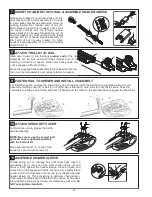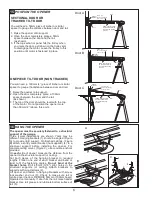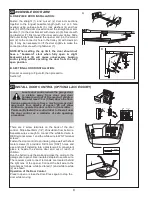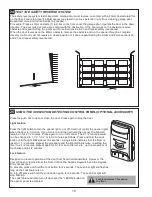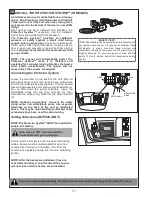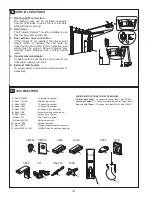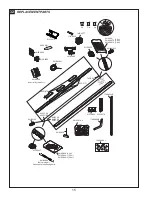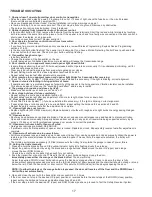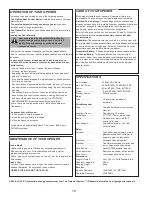
TROUBLE SHOOTING
1. Opener doesn't operate from either door control or transmitter:
• Does the opener have electric power? Plug lamp into outlet. If it doesn't light, check the fuse box or the circuit breaker.
(Some outlets are controlled by a wall switch.)
• Have you disengaged all door locks? Review installation instruction warnings on page 1.
• Is there a build-up of ice or snow under door? The door may be frozen to ground. Remove any obstruction.
• The garage door spring may be broken. Have it replaced.
2. Opener operates from transmitter but not from door control:
• Is door control button lit? If not, remove the bell wire from the opener terminals. Short the red and white terminals by touching
both terminals at the same time with a piece of wire. If the opener runs, check for a faulty wire connection at the door control, a
short under the staples, or a broken wire.
• Are wiring connections correct? Review section 21.
3. Door operates from door control but not from transmitter:
• Replace battery if necessary.
• If you have two or more transmitters and only one operates, review Wireless Programming, Keyless Device Programming
sections 27 to 29.
• Is the door control button flashing? The opener is in lock mode. If you have a Motion Detecting Control Panel, push and hold
the Lock button for 2 seconds. The door control button will stop flashing.
4. Transmitter has short range:
• Is battery installed?
• Change the location of the transmitter on the car.
• A metal garage door, foil-backed insulation or metal siding will reduce the transmission range.
5. Door reverses for no apparent reason and opener light doesn't blink:
• Is something obstructing the door? Pull manual release handle. Operate door manually. If it is unbalanced or binding, call for
professional garage door service.
• Clear any ice or snow from garage floor area where garage door closes.
• Repeat Setting Limits and Force, see adjustment sections 22 and 23.
• Repeat safety reverse test after adjustment is complete.
6. Door reverses for no apparent reason and opener light blinks for 5 seconds after reversing:
• Check The Protector System™ (IR Beams) if you have installed this accessory. If the light is blinking, correct alignment.
7. Opener noise is disturbing in living quarters of home:
• If operational noise is a problem because of proximity of the opener to the living quarters, Vibration Isolator can be installed.
This kit was designed to reduce the "sounding board effect" and is easy to install.
8. The garage door opens and closes by itself:
• Make sure transmitter push button is not stuck "on".
9. Door stops but doesn't close completely:
• Repeat setting the limits, see adjustment section 22.
• Repeat safety reverse test after any adjustment of door arm length, close force or down limit.
10. Door opens but won't close:
• Check The Protector System™ (if you have installed this accessory). If the light is blinking, correct alignment.
• If opener light does not blink and it is a new installation, repeat setting the limit and force sections 22 and 23.
• Repeat the safety reverse test after the adjustment is complete.
11. Opener light does not turn on:
• Replace light bulb (230V/40W maximum). Replace burned out bulbs with rough service light bulbs or energy saving Halogen
light bulbs.
12. Opener strains:
• Door may be unbalanced or springs are broken. Close door and use manual release rope and handle to disconnect trolley.
Open and close door manually. A properly balanced door will stay in any point of travel while being supported entirely by its
springs. If it does not, call for professional garage door service to correct the problem.
13. Opener motor hums briefly, then won't work:
• Garage door springs are broken. SEE ABOVE.
• If problem occurs on first operation of opener, door is locked. Disable door lock. Repeat safety reverse test after adjustment is
complete.
14. Opener won't activate due to power failure:
• Pull manual release rope and handle down to disconnect trolley. Door can be opened and closed manually. When the power is
restored, pull the manual release handle down and toward opener. The next time the opener is activated, the trolley will
reconnect.
• The Outside quick release accessory (if fitted) disconnects the trolley from outside the garage in case of power failure.
15. Setting the limits manually:
1. Press and hold the black button until the yellow indicator light starts flashing slowly then release.
2. Adjust the position of the door by using the black and orange buttons. Black moves the door UP (open) and orange
moves the door DOWN (close).
Check to be sure the door opens high enough for your vehicle.
3. Push the transmitter or door control. This sets the UP (open) limit and begins closing the door.
Immediately press either the orange or the black button. The door will stop.
Adjust the desired DOWN (close) limit position using the black and orange buttons. Check to be sure the door is fully
closed without applying excessive pressure on the rail (rail should not bow upwards and the chain/belt should not sag or droop
below the rail). Push the transmitter or door control. This sets the DOWN (close) limit and begins opening the door.
NOTE: If neither the black or the orange button is pressed, the door will reverse off the floor and the DOWN travel
limit will be set automatically.
4. Open and close the door with the transmitter or door control 2 or 3 times.
• If the door does not stop in the desired UP (open) position or reverses before the door stops at the DOWN (close) position,
repeat setting the limits and force, see adjustment sections 22 and 23.
• If the door stops in both the desired UP (open) and DOWN (close) positions, proceed to Test the Safety Reversal System.
17


